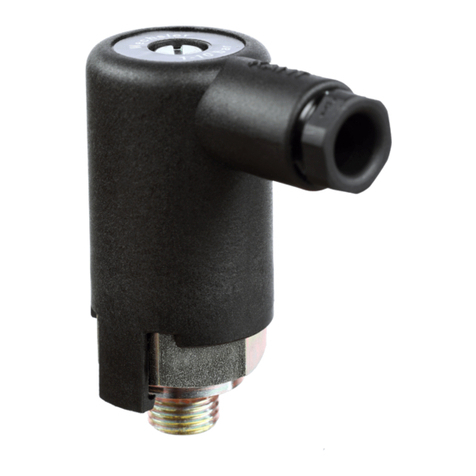
ASSEMBLY
Connect the pressure switch to the pressure connection (1) (observe maximum tightening torque). Use a suitable sealing ring for sealing.
Type 902-P
Insert the supplied O-ring into the connection hole (8) and fasten the pressure switch with the drilled holes (7) provided for this purpose using two
M5 screws.
For the electrical connection use the supplied cable plug.
Make sure that the cable is laid without kinks or squeezing.
Cabling of the cable plug:
Loosen the fastening screw (2) until the cable plug (5) can be removed.
Push the connecting plate out of the cable plug (5).
Connect the cables (max. conductor cross-section 1.5 mm2) to the screw terminals.
Slide the connecting plate into the plug housing (6) and mount it with the fastening screw (2).
Plug the cable plug (5) onto the pressure switch and mount and tighten the fastening screw (2).
Ensure that the strain relief is properly installed to ensure its function and degree of protection.
COMMISSIONING
Loosen the fastening screw (2) and remove the cable plug (5).
Wire the electrical connections according to the schematic diagram.
Loosen the lock nut (3). Turn the knurled screw (4) by hand as far as possible.
Apply the desired switching pressure to the pressure switch.
Unscrew the knurled screw (4) until the pressure switch switches and outputs the electrical signal.
Check the switching signal by switching the pressure on and off. Correct any error by adjusting the knurled screw (4).
When the adjustment is complete retighten the lock nut (3).
Attach the cable plug and fasten by tightening the fastening screw (2).
When commissioning the pressure switch, please observe the relevant safety regulations of the employers' liability insurance association or the
respective national regulations.
DISASSEMBLY
Follow these instructions when removing the pressure switch:
The pressure switch must be in a pressureless and deenergised state.
Use a suitable tool to disassemble the pressure switch on the provided wrench surfaces or hexagonal profiles.
Damage may occur if other surfaces or unsuitable tools are used.
Always observe all relevant safety regulations.
NOTE
The data and descriptions in this manual have been compiled to the best of our knowledge. However, the manufacturer cannot be held liable for
errors. In any case, the operator must ensure that a failure or defect of the product cannot lead to further damage.
Caution: Tighten the pressure switch only on the metal housing - risk of damage!
Caution: Observe the permissible electrical switching capacity - risk of damage!





















